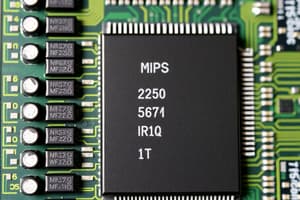Podcast
Questions and Answers
What happens when the serial output of a shift register is connected to its serial input?
What happens when the serial output of a shift register is connected to its serial input?
- Circular shift left (correct)
- Arithmetic shift left
- Circular shift right
- Arithmetic shift right
In arithmetic shift, what operation is carried out when shifting a signed binary number to the left?
In arithmetic shift, what operation is carried out when shifting a signed binary number to the left?
- Multiplication by 2 (correct)
- Division by 2
- Addition by 2
- Subtraction by 2
What should remain unchanged in an arithmetic shift operation for a signed binary number?
What should remain unchanged in an arithmetic shift operation for a signed binary number?
- Least significant bit
- Most significant bit
- Middle bit
- Sign bit (correct)
What mathematical operation does an arithmetic shift-right perform on a number?
What mathematical operation does an arithmetic shift-right perform on a number?
Which type of micro-operation involves shifting registers?
Which type of micro-operation involves shifting registers?
What happens to the information during a circular shift operation?
What happens to the information during a circular shift operation?
Which mathematical operation is NOT performed by an arithmetic shift-right?
Which mathematical operation is NOT performed by an arithmetic shift-right?
What does an arithmetic shift-left do to a binary number?
What does an arithmetic shift-left do to a binary number?
Flashcards are hidden until you start studying
Study Notes
Operand Data Types
- Operands indicate the source address or data for processor operations.
- Operand data types typically denote size implicitly; common types include:
- Addresses: Indicate location in memory or registers.
- Floating Point Numbers: Include single (1 sign, 8 exponent, 23 mantissa bits) and double precision (1 sign, 11 exponent, 52 mantissa bits).
- Fixed Point Numbers: Can be signed or unsigned.
- Characters: Various encodings like ASCII, EBCDIC.
- Logical Data: Restricted to 0 or 1 values.
- Binary Coded Decimal (BCD): Represents decimal digits in binary format.
Instruction Execution
- CPU's primary function is to execute instructions, requiring multiple steps collectively known as the instruction cycle.
- Each instruction execution comprises micro-operations, the smallest units of task performed by the CPU.
- Basics of CPU structure include:
- Arithmetic Logic Unit (ALU)
- Control Unit
- Operational Registers
- Register organizations vary, with specific roles assigned to each register in data handling.
Register Organization
- Registers have designated roles:
- $zero (0): Always zero.
- $at (1): Reserved for assembler.
- $v0 - $v1 (2-3): Function value registers.
- $a0 - $a3 (4-7): Argument registers.
- $t0 - $t7 (8-15): Temporary registers.
- $s0 - $s7 (16-23): Saved registers.
- $t8 - $t9 (24-25): Additional temporary registers.
- $k0 - $k1 (26-27): Reserved for OS.
- $gp (28): Global pointer.
- $sp (29): Stack pointer.
- $fp (30): Frame pointer.
- $ra (31): Return address register.
Micro-Operation Concepts
- Micro-operations form the foundation of instruction execution, typically occurring within one clock cycle.
- Operations include:
- AND Operation: Clears bits in one register based on conditions set by another (e.g., R1 AND R2).
- Exclusive-OR Operation: Complements specific bits in a register as defined by another register.
- Masking: A two-step process to insert values by first clearing existing bits and then setting new values using OR operation.
- Clearing Bits: Preferable through AND micro-operation, masking unwanted values out based on another register's bits.
Summary
- Understanding operand types and register organization is crucial for effective instruction execution.
- Micro-operations enable detailed control over data manipulation within the CPU, essential for executing complex tasks efficiently.
Studying That Suits You
Use AI to generate personalized quizzes and flashcards to suit your learning preferences.



